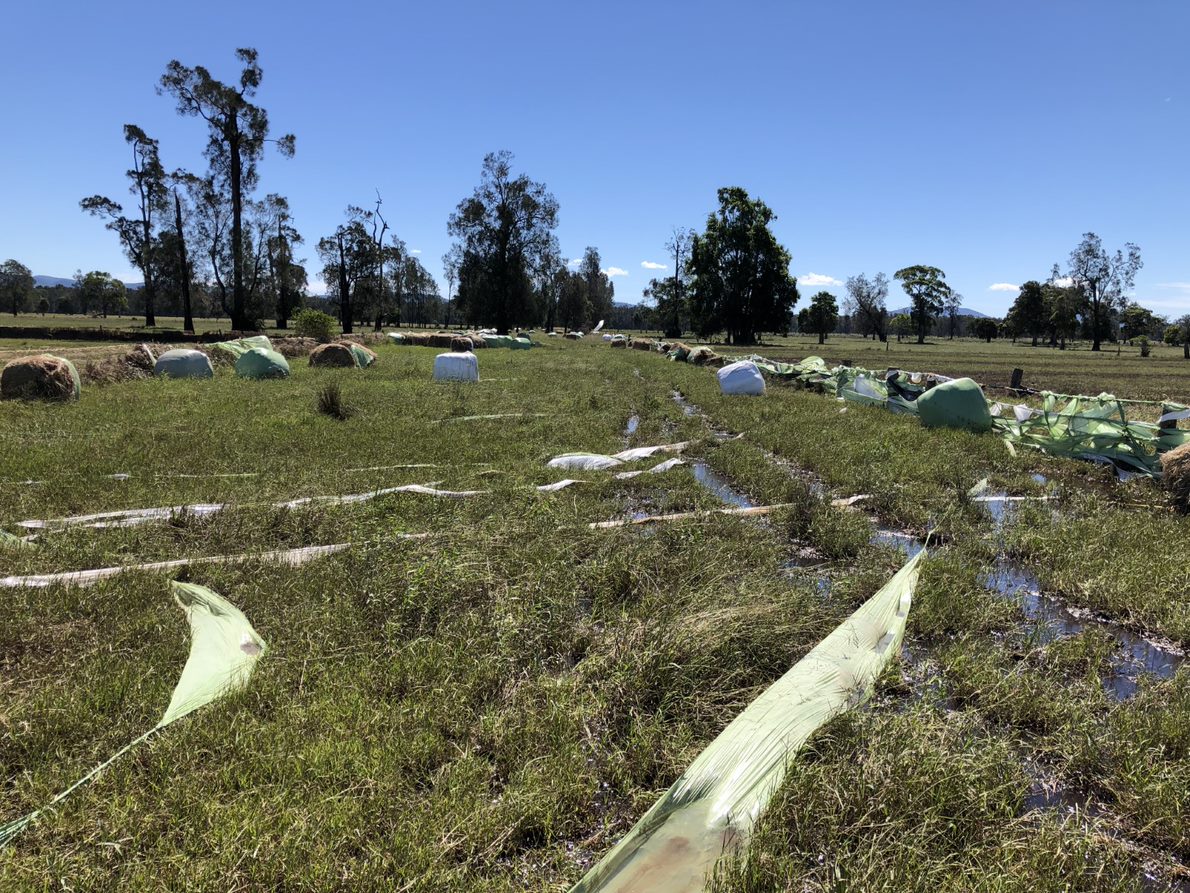On-farm composting of flood spoilage
After significant flood events, landholders often face the challenge of managing contaminated and spoiled feed (including grain, hay, and silage) and disposing of animal carcases. For producers looking to manage flood spoilage, composting on farm may be the best option.
How to use spoiled forages
After wet weather and floods, many farmers will have spoiled bales of silage, hay and sometimes grain. Water damaged feed should be inspected to ensure it does not pose a health risk to livestock.
For flood damaged fodder that can not be salvaged, there are many ways to make use of water damaged hay bales to turn your spoiled forages into a useful resource, such as:
- Sell (or give away) spoiled materials as mulch. Many gardeners and some growers of small crops such as garlic prefer grassy material as mulch. Poorer quality tropical grass hay is ideal.
- Use spoiled forages on laneways and hardstand livestock holding areas to absorb urine and manure, and then take the material away for aerobic composting. This is useful on dairy yards during droughts where yard wash water may be limited.
- Compost the forages on-farm to recycle nutrients and improve soil carbon
- Use forage materials to compost livestock mortalities.

On-farm composting after flood
Composting is a way to turn a waste product into a useful resource to improve soil health and recycle nutrients. It is important that on-farm composting is conducted with due care to the environment. Most states have rules as to best management practices to minimise odours and run-off.
In NSW large commercial composting facilities that require a licence are subject to regulatory guidelines by the Environmental Protection Authority. For more information, a PDF download is available outlining these guidelines for Composting and Organics Processing Facilities.
Smaller on-farm or home composting usually does not require a licence, but care should still be taken to minimise environmental impacts. The Dairying For Tomorrow website has a range of resources for managing on-farm composting.
Choosing a compost site
When choosing a compost site, ensure that:
- Soils under the site are relatively impermeable, to reduce leachate impact on aquifers - a concrete pad, or other compacted, clay-based soil area is ideal.
- The area is at least 2m above the water table.
- The site will be flat or have a slight slope (<5%) and be accessible to tractors and other machinery used to turn the compost pile.
- The site is away from watercourses, preferably above major flood level.
- The site is well away from neighbours’ dwellings, or other sensitive areas such as waterways and public facilities. If using the area to compost livestock carcases, a site out of view from neighbours and public roads is essential.
Composting of spoiled feed and manures
For large amounts of spoiled feed, a windrow composting method is most easily managed and cost effective. This composting process relies on micro-organisms (fungi and bacteria) to decompose organic materials in the presence of oxygen.
Most silage spoilage occurs when holes in the wrap allow oxygen into the bale (known as aerobic spoilage). White fungal growth is a sign that the composting process has already started. The process can be completed by adding other woody materials and manures and with regular turning and adequate moisture.
When composting spoiled silage, remove as much plastic bale wrap, netting and twine from the material as possible. Dispose this in landfill or to agricultural plastics recycling schemes.
Forming the material into large windrow piles allows relatively simple turning using either a front-end loader bucket, or a specialised windrow mixer. For smaller compost areas, making a three-sided bin with hard sides can make turning easier, as there is a hard wall to push up against with a tractor bucket, or for domestic piles- a large garden fork.
Composting of mortalities
On-farm mortality composting is an efficient way to dispose of animals that have died on farms without access to knackery and rendering services. Make sure to call a veterinarian to investigate animal deaths with an unknown cause or with unusual symptoms to rule out Emergency Animal Disease, as these animals may be unsuitable for disposal by composting.
Setting up a mortality compost pile is slightly different to general composting. A deep absorbent layer of carbon rich material (sawdust, woodchips) should be prepared underneath the carcass, to absorb liquids. Spoiled, wet hay and silages with excess moisture levels are better used on top of the pile. Approximately 10-12 cubic metres of material is required to compost an adult cattle carcass.
As the developing compost contains “restricted animal material” (RAM) the composting site must be fenced to exclude livestock. If desired, a small mortality compost pile can be fenced using gates, to help contain composting materials and prevent scavenging by wild animals.
The process differs from general compost making as the pile needs to remain undisturbed for four to six months before it is turned. This is to allow soft tissue to break down and bones to soften. Once this first decomposition phase has passed, the regular composting process applies. Any remaining large bones should be removed from the compost before it is spread. They can be added to a new compost pile.
Composts containing animal material can be applied to pastures, however, a 28-day grazing withholding period applies. This is to make sure there are no animal remains still present that can cause Botulism disease or break the rules for feeding restricted animal products. It also allows pasture to grow through the compost to reduce access by livestock.
To learn about other methods of managing mortalities, read our guide to animal disposal after flood.
EPA Heavy Rainfall Events Information
Information from the Victorian EPA on how heavy rainfall events impact waterways, wastewater treatment plants, and stormwater and sewerage systems can be found on their website.